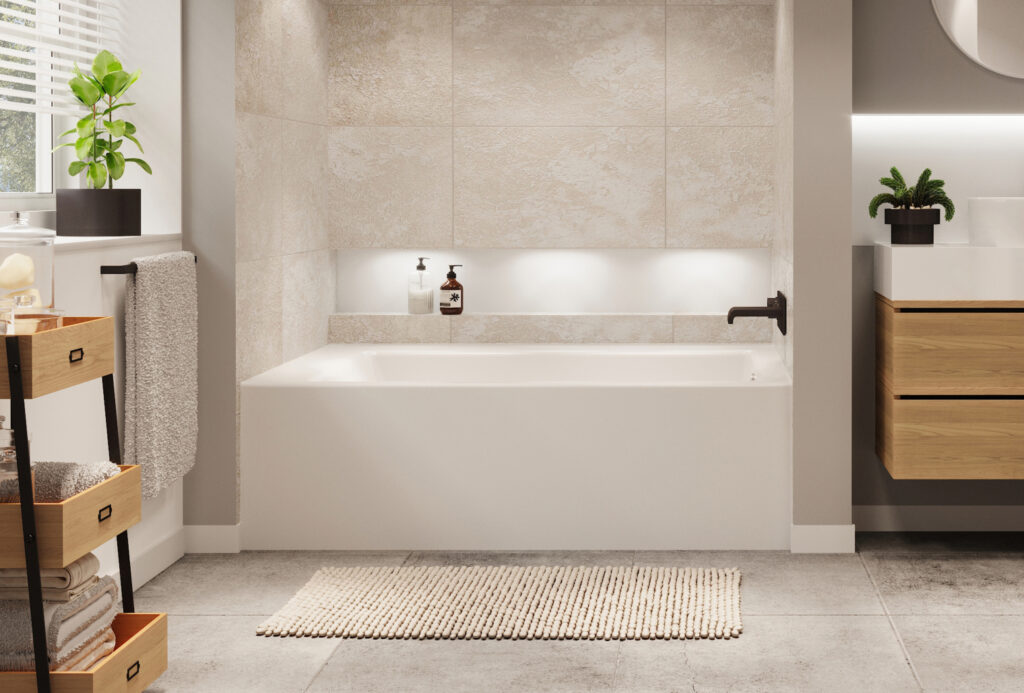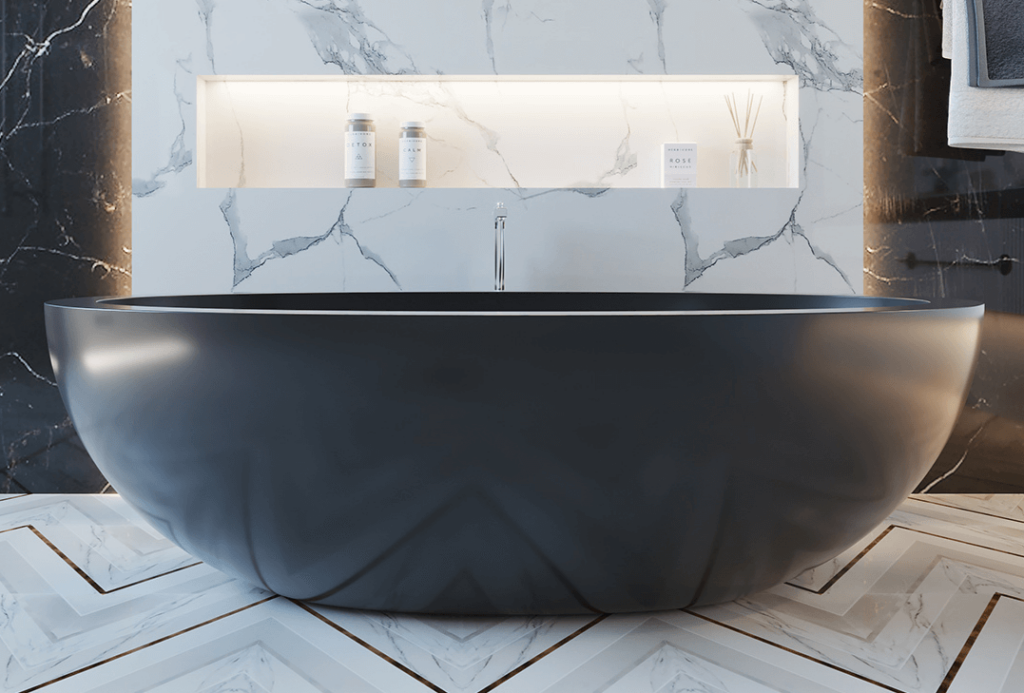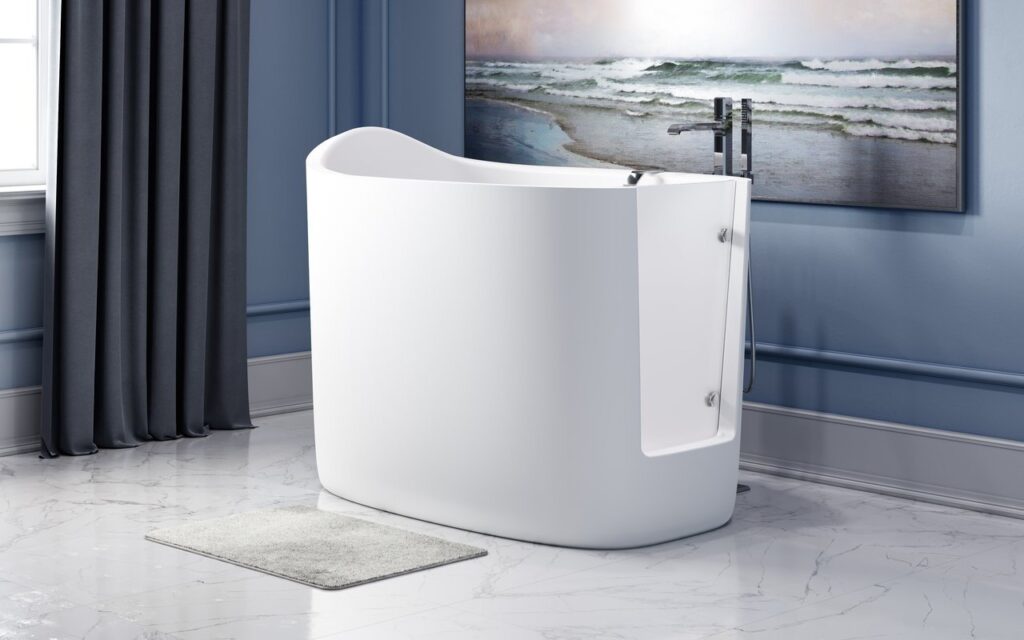When it comes to creating a sanctuary in your home, your bathroom can be a quiet oasis to get away from it all. And what better place to drift away in your thoughts than the bathtub? For some, it’s all about functionality. However, you see it as a statement piece. A haven of relaxation and a reflection of your style. Among the sea of choices, oval bathtubs are as popular as ever, offering a perfect blend of aesthetics and comfort.
But how do you choose which type of bath is the best fit for your current layout, lifestyle, and wallet? In this post, we’ll dive into the different types of tubs, their materials, and other factors like weight, which should be considered when choosing your next bathtub.
Common Bathtub Styles
Freestanding Tubs
Free bathtubs are a favourite for those looking to add a touch of elegance to their bathroom. Unlike other options, a freestanding tub does not need to be against a wall. They are available in various shapes, including oval, rectangular, and round, to match your style.
But there is a catch. Freestanding tubs work best in a large layout with plenty of square footage if you want it to be the centrepiece of the bathroom. Sure, you can place one in the corner of a small bathroom, but you lose its “wow” factor.
Soaking Tubs
If you want to relax, soaking bathtubs are ideal. These tubs are designed for long, comfortable socks. Common features found on soaking bathtubs include ergonomic contours and optional amenities like heating and ambient lighting.
Jet Tubs
Similar to an outdoor hot tub, jetted bathtubs provide a therapeutic touch thanks to powerful air and water jets that massage your body. The standard house jetted tub will have six to eight jets that are run off a single pump.
Tub and Shower Combos
Tub and shower combos come in most run-of-the-mill houses. They offer a practical solution for smaller bathrooms, combining the convenience of a shower with the comfort of a tub. Available in various styles, tub and shower combos can be purchased with or without a glass shower door.
Alcove Tubs
Alcove bathtubs are designed to fit into a three-walled space and are easy to install, making them the perfect candidate for a home DIY-er. The best Part? Their simple, neutral look goes well with any style.

Common Materials
Selecting the best type of bathtub material is as important as choosing the style. Each material comes with distinct benefits and drawbacks.
Acrylic
Acrylic bathtubs are known for their durability and versatility. The material is lightweight, making installation easier. Once in place, an acrylic tub requires almost no maintenance. It’s a little more expensive than fibreglass, but the added flexibility and durability make up for it.
Fibreglass
Fibreglass is the most economical option. These tubs are made of moulded fibreglass sheets with a gel coat finish. While easy to install, they are more prone to scratches and cracks compared to other materials.
Porcelain-Enamel
Typically made of iron or steel, porcelain enamel tubs feature a glossy enamel finish. What makes them great is their excellent heat retention capability and durability. They resist scratches and dents, making them a top contender for the best tub material.
Copper
Copper bathtubs are all the rage nowadays. They are malleable yet highly durable. The initial cost will sting, but they look fantastic and last forever.
Stone Resin
A stone resin tub is meant to be the centrepiece of any bathroom. You won’t have to worry about stains, mildew, scratches, and cracks if you opt for this bathtub.

Things to Consider
Next to the price, the bathtub weight is one of the most important aspects to consider. Heavier materials like cast iron and stone require additional floor support if mounted on the second floor. Lighter materials, such as acrylic and fibreglass, offer more flexibility but take away from style and heat retention. Considering the overall weight is a necessity, especially if you are remodelling an existing space.
Specialised Bathtubs
Japanese Baths
Japanese baths are known for their compact design. A Japanese bathtub is perfect for tiny spaces and offers a unique experience due to its depth. So, it’s not only functional but also adds an element of cultural elegance to any bathroom.
Corner Tubs
Corner bathtubs are a fantastic space-saving solution. Not everyone has the real estate to put a tub in the middle of the bathroom. They are larger but fit perfectly in the corner, making them ideal for small spaces.
Walk-In Tubs
Designed for accessibility and safety, walk-in bathtubs are an excellent choice for those with mobility challenges. These tubs typically feature a door for easy entry, built-in seating, and a non-slip surface for additional functionality and comfort.

Popular Choices
When it comes to the best bathtubs, three materials frequently come to mind: acrylic, porcelain, and stone. Each offers distinct advantages that make them popular choices among homeowners looking to remodel their bathrooms.
Acrylic: The Versatile Choice
Acrylic bathtubs are favoured for their versatility and affordability. They are lightweight, making installation a breeze, and their non-porous surface makes them easy to clean and maintain. Sadly, acrylic does not retain heat as well as its contenders.
Porcelain-Enamel: Classic and Durable
Porcelain-enamelled bathtubs offer a timeless look that never goes out of style. Their glossy finish resists scratching and fading. However, they are prone to chips and are heavier. Luckily, their longevity makes them a worthwhile investment.
Stone: The Epitome of Luxury
Most stone bathtubs are crafted from stone and resin mix but sometimes are carved out from a solid block. Yes, the cost is higher, but having one makes a bold statement in any bathroom. On top of that, a stone tub retains heat exceptionally well, providing a spa-like experience at home. Weight, however, is its only downside.
Conclusion
Choosing the best bathtub involves considering multiple factors, including the material, weight, and ease of installation. Whether you’re looking for an elegant porcelain-enamelled tub, a modern acrylic one, or the luxury of a stone bathtub, there’s a perfect option out there for every preference and style.
For even more lifestyle and general pieces like this one, click right here.